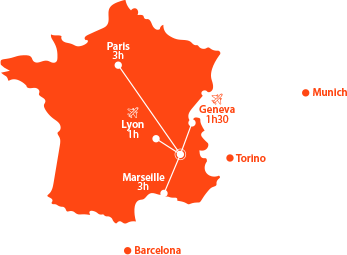At the heart of one of the wealthiest regions in europe
Home to 8 million residents and a thriving economy with 3 million jobs, Auvergne Rhone Alpes boasts a GDP of €250 billion, making it France’s second wealthiest regional economy.
At the heart of this flourishing region, Grenoble Alpes’ metropolitan area is one of the region’s main economic contributors, offering an array of highly-specified sectors – many on the cutting edge of their fields: micro/nanoelectronics, software development, medtech, energy, cleantech, mountain sports, and more.

A region with international reach
A mid-sized Metropolitan area (600,000 inhabitants), Grenoble Alpes has the largest English-speaking population in France outside of Paris. Situated at the intersection of three major European cities (Lyon, Turin and Geneva), the city enjoys a potential customer-base of 20 million people within a 200km (~125-mile) radius, and up to 60 million customers within a 500km (~300-mile) radius. It is an ideal location for companies doing business in Europe, the Middle East and Africa.
Each year, more and more French and international businesses choose Grenoble Alpes for its dynamic business and research sectors. Companies like Apple, Huawei and Prophesee have built R&D centers in the city, while others, like Plasmatherm and Naver Labs, have chosen it for their European headquarters. Some others, like BD and Caterpillar, longtime residents of the area, have chosen the city for the development or expansion of their production capabilities, often with the intention of being closer to regional subcontractors and research hubs. With highly-developed scientific infrastructure and an entire value chain of dynamic businesses, Grenoble Alpes is ripe with opportunities for companies seeking to innovate.

Pioneers of innovation
Historically, Grenoble Alpes has been a leader in scientific innovation and social progress. The appearance of hydroelectricity at the end of the 19th century led to the development of a diversity of industries in the region. The simultaneous development of the academic and industrial spheres intensified Grenoble Alpes’ reputation as a hub for new ideas and inventions.

In the 1950s, Grenoble became known as a pioneer in the field of computer science, inspiring several American and European corporations to move their activity to the area. At the impetus of two men, Jean Kuntzmann (founder of Grenoble’s first laboratory for applied mathematics and computer science) and Louis Néel (Nobel laureate in physics and initiator of Grenoble’s center for nuclear studies –known today as the CEA Grenoble), the city chose to invest heavily in scientific research. Since then, industrial and scientific research have evolved side by side: from hydraulics to electricity, electricity to physics, physics to mathematics, mathematics to computer science, computer science to nanotechnologies, and more…
Grenoble’s long-term investment in science has paid off: today, the city has become synonymous with innovation. A rich network of science & technology research centers has developed around a handful of internationally-acclaimed large science facilities. The construction of these facilities was the result of close international cooperation:
x Institut Laue Langevin (leading international neutron research center) ;
x EMBL (European Molecular Biology Laboratory) ;
x European Synchrotron Radiation Facility (global leader in x-ray science) ;
x Institut de radioastronomie millimétrique (global leader in radioastronomy) ;
x Laboratoire Européen de champs magnétiques (part of the European Magnetic Field Laboratory Network).
GRENOBLE ALPES: get ahead
In order to increase Grenoble’s reach, local actors have created a community around the banner “Grenoble Alpes”.
A collective action to promote a city that continues to attract innovative and pioneering projects in the domains of the energy transition, ecology and the social economy.
Spread the word about Grenoble’s activity by becoming a Grenoble Alpes pioneer!

